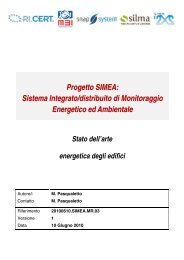Progetto SIMEA - Automatica - Università degli Studi di Padova
Progetto SIMEA - Automatica - Università degli Studi di Padova
Progetto SIMEA - Automatica - Università degli Studi di Padova
You also want an ePaper? Increase the reach of your titles
YUMPU automatically turns print PDFs into web optimized ePapers that Google loves.
<strong>SIMEA</strong> Stato dell’arte energetica <strong>degli</strong> e<strong>di</strong>fici<br />
1.2.37. PHPP<br />
69<br />
Doc.No 20100610.<strong>SIMEA</strong>.MR.03<br />
Versione 1<br />
PHPP calculates energy demand for buil<strong>di</strong>ngs. It<br />
is compatible with international norms (ISO 13790) and<br />
well validated with dynamic simulation tools as well as<br />
with measured data. It is especially adapted to highperformance<br />
buil<strong>di</strong>ngs and can be used to prove Passive<br />
House requirements. The planning package comprises many tools specifically useful for the design of highperformance<br />
buil<strong>di</strong>ngs.<br />
The Passive House Planning (Design) Package (PHPP) includes:<br />
• energy calculations (incl. R or U-values)<br />
• design of window specifications<br />
• design of the indoor air quality ventilation system<br />
• sizing of the heating load<br />
• sizing of the cooling load<br />
• forecasting for summer comfort<br />
• sizing of the heating and domestic hot water (DHW) systems<br />
calculations of auxiliary electricity, primary energy requirements:<br />
• (circulation pumps, etc.), as well as projection of CO2 emissions<br />
• verifying calculation proofs of KfW and EnEV (Europe)<br />
Climate Data Sheet: climate regions may be selected from over 200 locations in Europe and North<br />
America. User-defined data can also be used.<br />
1.2.37.1. Validation/Testing<br />
Basis for energy balance: ISO 13790. Tested with dynamic buil<strong>di</strong>ng simulation and with measured<br />
data in field project with some 1,000 apartments and ad<strong>di</strong>tionally with non-residential buil<strong>di</strong>ngs.<br />
1.2.37.2. Expertise Required<br />
Experience in buil<strong>di</strong>ng design or buil<strong>di</strong>ng energy consulting. PHPP training is recommended but not<br />
prerequisite. Use of manual (included).<br />
1.2.37.3. Users<br />
1,0000 users worldwide: 500 in the United States<br />
1.2.37.4. Au<strong>di</strong>ence<br />
Architects, engineers, energy consultants, scientists.<br />
1.2.37.5. Input<br />
Data are entered as numbers or chosen in menus. Needed: surface areas of thermal envelope, length of<br />
thermal bridges (optional), thermal characteristics of materials (thermal conductance) or buil<strong>di</strong>ng<br />
components (U-values), and of thermal bridges (optional); characteristics of ventilation system, efficiency of<br />
heat recovery, location of buil<strong>di</strong>ng. Characteristics of certified passive house buil<strong>di</strong>ng components are<br />
implemented.
















